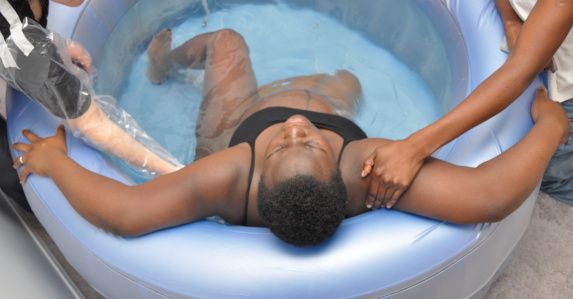If you decide to have an at-home birth, you might as well try out a water birth. Water birth is the process of giving birth inside water, as simple as that. Laboring in an empty bathtub or under the shower does not count. We understand that our mamas want to keep up with the latest trends. That’s why we curated this just for you.
This method of birthing has many advantages. Gravity plays a big role in a quicker easier birth. Here are all the things you should know before you have a water birth.
Advantages of Water Birth
- Pain reduction: Water helps manage labor pains greatly, from the point you start contracting till the point you have your baby. The water in the tub also acts as a heat conductor to help ease the pain of contractions.
- Low chances of perineum tear/ episiotomy tear: Episiotomy tear is the deliberate cut on your vagina by a physician to aid birth. The water increases the elasticity of the perineum and relaxes it.
- Reduced chances of postpartum hemorrhage: Having a water birth reduces the chances of heavy bleeding which could lead to death. A study carried out by a group of researchers on a total of 140 women, shows that severe hemorrhage was significantly lower in women who delivered in water.
- Endorphin release: Water birth helps convey endorphins around the body. Endorphins are chemicals that help relieve pain and stress.
- Increased blood flow: The warm water in the tub increases the blood flow to the uterine muscles resulting in less pain for the mother.
- Encourages active birth: All parts of your body are supported in this position with equal pressure everywhere, and again helps in reducing pain.
- Increased privacy: If many women had the liberty of "choice", not all would enjoy random people staring right into their vaginas. Granted, this would be the last thing on your mind when you are having crazy contractions. But now that you can still make decisions, be aware that with an at-home water birth, you can get more privacy, than you would otherwise.
There are also advantages for your baby. Babies birthed in water are generally calmer, more alert, maintain their birth temperature, and are less likely to end up in a special care unit.
In the largest observational study on water birth to date, involving case studies of 18,343 midwives in the US between 2004 - 2009, it was discovered that water birth reduces the risk of health complications in newborns. And overall these babies experienced better health outcomes than babies delivered normally.
Disadvantages of water birth
Most things in life have cons, and water birth is no exception. These are possible risks that you might encounter if you had a water birth at home.
- The baby's umbilical cord might snap while pulling them up from the water immediately after they are pushed out of the uterus.
- You could have slower contractions. Although the temperature of the water at water birth greatly helps to reduce the pain of contractions, the downside is that reduced contraction interferes with dilation and this could prolong your labor. This does not apply if you are 8cm dilated before you climb into the tub.
- There is a higher risk of infection if the birthing tub is not properly sanitized.
- From the point you decide to have a water birth, you do not have the option of using birth pain reliefs like an epidural.
- Safe water/home birth is an option that is not available in many regions and most maternity facilities in Nigeria.
Do you qualify for a water birth?
To be eligible for a safe home water birth, you need to be certain you do not have certain health complications. It is important because when birthing at home, helpful resources are inaccessible in case of emergencies in Nigeria. Checklist to know your status when opting for a water birth:
- Low-risk pregnancy.
- More than 37 weeks pregnant.
- Single pregnancy.
- Baby's head down.
- Baby measuring a normal size. Normal size is 18 - 22 inches, 5 - 8 pounds.
- BMI less than 35. Your BMI should be at least 35 to rule out the possibility of pregnancy-induced hypertension.
Facilities that Offer Water Birth Options in Nigeria
At the moment there are no renowned hospitals in Nigeria known to cater to this special kind of birth, but research shows that they exist. Discuss with your doctor at your next antenatal care appointment and know what your options are.
If having an at-home water birth is an option, here are some important things you should need.
- A certified midwife or OB/GYN: This is the most important. They should be present in your home for the birth. Also take extra caution to do your research, ensuring that they have prior relevant experience.
- A tub: If you do not have access to a big tub or any bathtub at all, there are options for an inflatable tub. The recommended size is 20 inches deep and 36 inches wide (interior). You can shop for inflatable water birth tubs on Alibaba.
- Water: The temperature of the water in your tub should be similar to the body's temperature. The recommended temperature is 35 - 37 degree Celsius.
- Birthing ball: this will help you exercise during labor and this can also help you relieve pain during contractions. You can order these on Jumia, and Ubuy.
- Bottled water: It is important to keep yourself hydrated during the whole course of your labor, it will keep your muscles working well and your energy up.
Some common positions you can assume for a water birth are:
- Kneeling or squatting is the most common position.
- Floating on your back. You can be supported with a pillow or partner.
- Floating on your stomach with your head turned sideways.
There are many misconceptions about having a water birth, especially at home in Nigeria, but water birth is safe when conducted with the assistance of professionals. Babies cannot drown during a water birth. So you don’t have to worry.
A water birth is an easier transition from the placenta fluid they lived in all those nine months. Their lungs have not been introduced to air and are still collapsed. No water can enter. Closely follow your physician's instructions, if you are unsure of birthing positions or have questions, always consult your midwife.
So mama, would you try a water birth for your next delivery? Let’s find out in the comments section.
Stay PreggSafe!











Comments